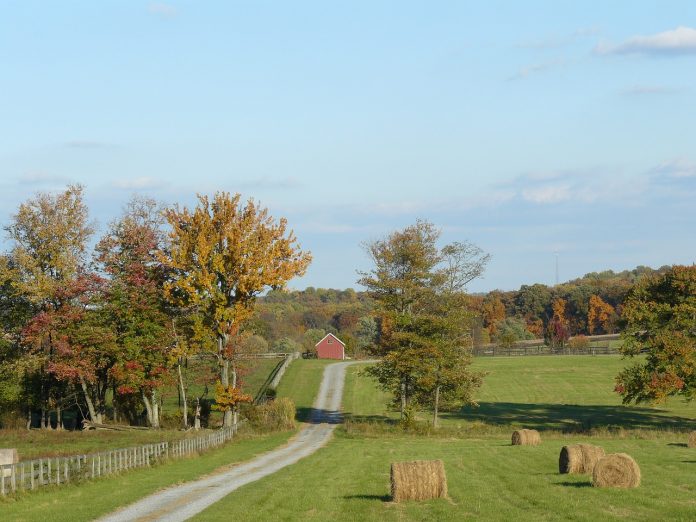Every good business starts with a plan. Developing a good conservation plan is the first step to managing the natural resources on your farm and ensuring those resources remain available for future generations.
When developing a conservation plan, a planner — or NRCS representative — guides landowners through the entire planning process, walking the land and making sure the landowner’s conservation goals are met.

1Planning
The first step in developing any management plan is to identify problem areas and opportunities. Landowners can use these areas to define their objectives and goals for the land.
The early planning process is also a good time to take an inventory of the natural resources available and further identify the problems and opportunities.
2Analyze
Once information about the land has been collected — through soil surveys, aerial imagery, etc. — the planner will analyze the data and define existing conditions for all the identified natural resources including limitations and potentials for land use.
From there, the planner helps the landowner develop alternatives for land uses based on the condition of the land and owner’s objectives for the land.
3The plan in action
After evaluating the alternatives to determine which will be the most effective in accomplishing the landowner’s goals, the landowner selects his or her preferred alternative and works with the planner to implement the new practice.
4Evaluate
The planner works with the landowner to make adjustments as needed. The final plan provides a roadmap for meeting conservation goals by showing how each practice benefits the farm or woodland, how to maintain that practice, and how the practice benefits soil, water and wildlife.
Developing a plan for your land also makes it easier to identify how and when you could qualify for financial assistance to help offset the cost of implementing new conservation practices.
This month we will break down different services provided by the NRCS each week, wrapping the series up with how you can get started with NRCS.
Next week: Financial assistance.
Sources: NRCS.
(Farm and Dairy is featuring a series of “101” columns throughout the year to help young and beginning farmers master farm living. From finances to management to machinery repair and animal care, farmers do it all.)
More Farming 101 columns:
- How can NRCS help you?
- More airborne hazards on the farm
- 5 airborne hazards to beware of on the farm
- 5 things to know about Wagyu beef
- Pennsylvania utility vehicle laws
- Ohio utility vehicle laws
- Farm chemical safety checklist
- When should a farm become a business entity?
- Harvest prep: Check your yield monitors
- How to tag livestock properly
- 6 tips for decision making on a family farm
- 8 tips to prepare your farm for agritourism
- How to plan for farm emergencies
- 7 keys to success on the farm
- 7 tips for healthy fair animals
- 5 tips to ensure livestock health before the fair
- 6 tips to keep your livestock parasite free
- 6 tips for vaccinating your livestock
- 5 tips to prevent dairy cow foot problems
- 6 common foot problems found in dairy cows
- Recognize, prevent heat stress in dairy cattle
- How to monitor your dairy herd
- How to start your own dairy farm
- 5 tips for sun safety in the field
- Employing youth for the summer
- What to do if a hay fire occurs
- How to prevent hay fires
- How to extend the life of your fence
- 10 safety tips for installing electric fences
- How to chose the right fence for your farm
- How to create a fencing plan
- 7 steps for easy sprayer calibration
- Prepare for planting season, Part 2: Calibration
- Prepare for planting season, Part 1: The Basics
- 7 tips to improve security on your farm
- 5 tips to protect your farmland
- 3 measures to deal with severe farm debt
- How to buy time to catch up on farm debt
- 6 tips to manage income on the farm
- 5 tips to recognize and deal with farm stress
- How to prepare a livestock birthing kit
- 5 tips for marketing your farm
- How to develop farm mission, vision statements
- 5 tips for setting farm goals
- 2 types of livestock insurance policies
- 6 things you need to know about WFRP plans
- 3 basics of crop insurance
- How does liability insurance work on the farm?
- Why do I need farm insurance?
- How to understand and use Ohio’s CAUV
- How to utilize the Pa. Clean and Green Act
- 9 tips for filing farm taxes
- 8 reasons record keeping for taxes is essential
- 5 tips for post-harvest storage
- 7 tips for family meetings on the farm
- 4 tips for balancing your farm and family
- 4 tips for communicating on the family farm
- 4 tips for firing an employee
- 6 tips for keeping good farm help
- 4 tips for recruiting farm labor
- 5 general farm labor laws
- 4 tips for employing minors
- 4 tips for PTO safety
- 5 things young farmers should know about finances
- The farm balance sheet
- 5 items for your farm’s cash flow statement
- Personal and business records: Keep them separate
- What to include in your farm business plan
- How to approach a lender: Tips for getting a farm loan
- How to use microloans to get your farm started
- Saving for the future: 6 tips for young farmers
- How to create a farm safety kit
- 5 tips for child safety on the farm
- 4 tips for transporting livestock
- 5 ways to better understand tractor stability
- 6 farm equipment hacks











